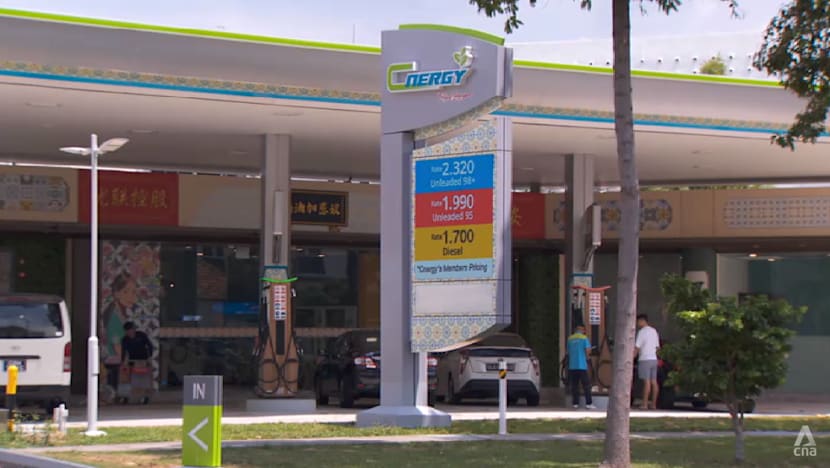Petrol stations in Singapore evolve to serve EV drivers and walk-in customers
As Singapore transitions to electric vehicles, petrol stations are reevaluating their food and lifestyle options to prepare for longer charging stops.

Cnergy's petrol station along Dunman Road. The operator plans to convert a corner currently occupied by vending machines to small food stalls serving Peranakan cuisine early next year.

This audio is generated by an AI tool.
SINGAPORE: Petrol stations in Singapore are diversifying their offerings to serve not only motorists, but also walk-in customers and nearby residents.
Operators say this strategy prepares them for the shift towards electric vehicles (EVs), when drivers may spend more time at service stations while their cars charge.
NEIGHBOURHOOD FOCUS
At a Cnergy petrol kiosk along Dunman Road in Katong, which opened last month, a mural depicting Joo ChiatŌĆÖs conservation shophouses pays tribute to the areaŌĆÖs Peranakan heritage.
There are plans to convert a corner of the station ŌĆō currently occupied by drinks and snacks vending machines ŌĆō to small food stalls serving Peranakan cuisine early next year.
CnergyŌĆÖs owner is Union Gas Holdings, which entered the petrol station business in 2009 with a kiosk in Old Toh Tuck Road.

Its CEO Teo Hark Piang said the goal is for its stations to blend in with the community.
ŌĆ£It depends on what kind of services you provide in your stations. Like for our station (at Katong), we focus mainly on F&B,ŌĆØ he said.
ŌĆ£It does not just provide services for drivers ŌĆ” we can see an increase in walk-in customers, nearby residents coming in to grab food and drinks.ŌĆØ
Each of CnergyŌĆÖs two service stations is equipped with four EV fast chargers. The company plans to open two more stations ŌĆō in Queensway by 2026 and Marsiling by 2027.
A direct-current fast charger can typically bring an EV battery to 80 per cent in about 30 minutes.
EVs accounted for about four in 10 new car registrations in the first half of 2025, a 63 per cent rise from the same period in 2024.
Singapore will stop registering new petrol cars by 2030, and targets to have an entirely cleaner-energy vehicle population by 2040.
REINVENTING THE PIT STOP
At ShellŌĆÖs Telok Blangah outlet, a compact ŌĆ£gym podŌĆØ allows customers to squeeze in a workout. The operator said it is the first such facility at a service station in Singapore.
Shell has installed EV chargers at 28 of its 56 stations ŌĆō with more planned ŌĆō to cater to an increasing number of EV users.
Mr Doong Shiwen, ShellŌĆÖs general manager for mobility and convenience in Singapore, said the company noticed EV drivers idling at its stations while their vehicles charged.

ŌĆ£They were asking us: ŌĆśCan you give me something more to do to fill my time?ŌĆÖŌĆØ he said.
The energy giant has previously introduced McDonaldŌĆÖs drive-throughs, a tie-up with wine marketplace Vivino and various pop-up concepts, as part of its efforts to offer customers more options.
Mr Doong said activities such as pop-ups help bring ŌĆ£a little more excitementŌĆØ to the kiosks, pointing to a recent National Day initiative featuring old-school ice cream carts.
He added that such efforts are also a way to support local businesses.
POTENTIAL COMMUNITY SPACES
Associate Professor Walter Theseira from the Singapore University of Social SciencesŌĆÖ School of Business said the shift from petrol to EVs will be gradual, which gives service kiosks time to adjust and find new ways to stay relevant.
The business model for petrol stations has long been to sell ancillary and convenience services besides petrol, he noted.
Operators are also diversifying their revenue streams as fuel sales decline due to more efficient vehicles.
ŌĆ£The margins on these ancillary services are often better than the petrol itself,ŌĆØ he said.
As fuel sales drop, operators that do not pivot may have to bow out. As many petrol stations occupy prime land in residential areas, they have significant potential to be repurposed for community use, said Assoc Prof Theseira.
But converting petrol stations to pure EV charging stations may not be realistic for Singapore, as they are typically practical for long-distance travel, for instance along MalaysiaŌĆÖs highways, Assoc Prof Theseira said.
ŌĆ£The idea of having a (dedicated) EV charging hub doesn't make a lot of sense. In Singapore, users would prefer to bring their EV to a shopping centre, plug in the vehicle, go and eat a meal, and go and run some errands,ŌĆØ he added.
According to the Urban Redevelopment Authority, there are about 180 petrol stations islandwide.
The authority said future plans for these sites will consider evolving land-use needs, including SingaporeŌĆÖs growing adoption of EVs.













